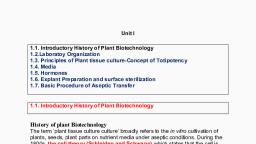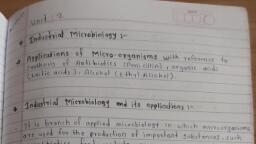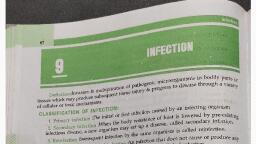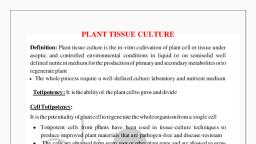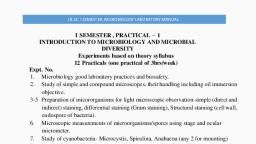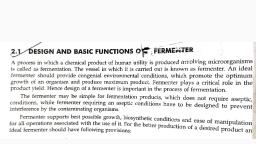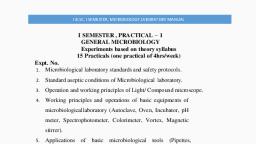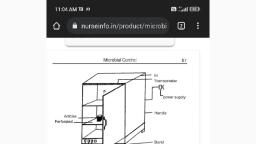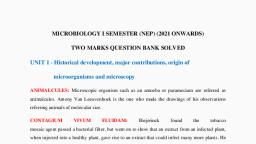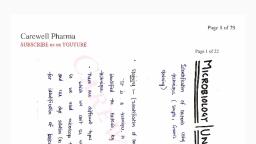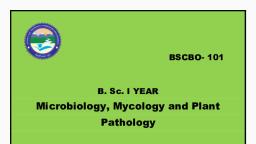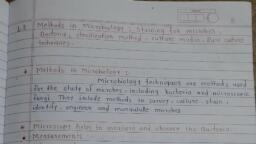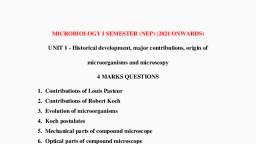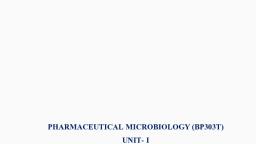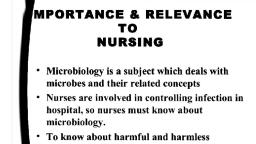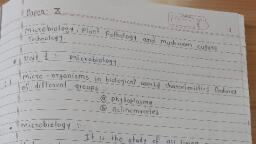Page 1 :
EMICAL METHODS, , , , MICR, 7 CHiAL CONTROL BY PHYSICAL, , “Gi INTRODUCTION, , The w :, was predominanly inns ly accepted and recognized concept and idea of ‘microbial control, Fesearchers, namely ; in the domain of microbiology by two altogether entirely different dedicated, , i Semmelweis (1816 — 1865)—Hungarian Physician ;, , foseph Lister (1827~1912)—British Physician., , Interestingly, Ser, wash the hands of all, , ‘mmelweis was pioneer in the introduction of strict mandatory procedures 10, 38% available chlori, , Personnels with chlorinated lime water (i¢., bleaching powder containing approx., tare “hlorine), which procedure significantly reduced the exhorbitant rate of infection. Likewise,, Sccomplished enormous success by treating the surgical wounds with solutions of ‘phenol’ (i., carbo! lic acid) ; ever the surgical Procedures were carried out in an adequate carbolic acid aerosol, environment, which in tum drastically minimized the incidence of any probable wound infection., , ___ Since a long stretch of nearly 150 years from Semmelweis ; and almost 100 good years from, Lister there have been really a sea-change with respect to the highly specific and precise manipulative,, logical, and scientific control of the ‘microbial growth’ both by physical methods and chemical, methods., , Now, each of these nvo aforesaid methodologies will be treated individually inthe sections hat, follows with appropriate typical examples wherever necessary., , =) Prysicat metHoos, , ‘The physical methods related to microbial control (or growth) are as enumerated under =, (a) Heat,, , (6) Moist Heat,, 198, , , , MICROBIAL CONTROL BY PHYSICAL AND Cittauene: meri n, , {c) Pasteurization,, (d) Dry-Heat Sterilization,, (¢) Filtration,, (Cold,, (g) Desiccation,, (h) Osmotic Pressure, and, hon,, tenia methods shall now be ueated separately in the sections that follows :, , |, , ably the most common effective, and productive means whereby organisms, are ase cies is gel practice to have the laboratory media, laboratory glasswares, and, hospital surgical instruments adequately sterilized by heat Le., moist heat in an electric autoclave., , Salient Features, Following are the salient features of heat controlled microbes, namely :, , (1) Most economical and easily controlable means of microbial growth., , (2) Usually kill microbes by causing denaturation of their respective enzymes., , (3) Heat resistance capacity of the organism must be studied carefully and taken into consideration,, , (4) Thermal Death Time (TDT). TDT is referred to as the minimal length of time whereby all, microbes present in a liquid culture medium will be killed at a given temperature., , (5) Thermal Death Point (TDP). TDP designates the lowest temperature at which all of the, microorganisms present in a liquid suspension will be killed in just 10 minutes. In fact, heat resistance, predominantly varies amongst the different range of organisms ; besides, these glaring differences may, be duly expressed via the concept of thermal death point (TDP)., , However, it is pertinent to state here that both TDP and TDT are equally vital, important, and, ‘useful guidelines which essentially indicate the actual prevailing severity of treatment needed to kill a, given population of organisms., , (6) Decimal Reduction Time (DRT or D-Value]. DRT or D-Value represents a 3rd concept, which is directly associated with the organism's extent of heat resistance. In fact, it is very much, equivalent to the time (minutes), whereby almost 90% of the population of prevailing microbes at an, exact specified temperature shall be killed as illustrated in Fig. 7.1, having DRT of J minute. It is,, however, pertinent to mention here that DRT is of an extreme importance and usefulness in the, , “canning industry’ dealing with [ruit concentrates, fruit pulps, fruit slices, baked beans, comed-beef,, fish products, fish chuncks, baby corns, lentils, and the like., , , , Scanned with CamScanner
Page 2 :
Fig. 7.1. Microbial Death Curve., , {Redrawn From : Tortora, t GJet.al.:M : are 2, Pub. Co. Inc. New York, Sth edn., 1995), Microbiology : An introduction., The Benjamin/Cummings, , ‘The curve in F, , , , is plotted logarithmically (as shown by solid line), and arithmatically, , {as shown by broks i :, iis ol ek a = Nine). In this particular instance, the microbial cells are found to be dying at a, , Ivis a common practice to make use of *heat’ in the process of sterilization either in the form of, ‘moist heat’ or ‘dry heat’,, Ithas been duly proved and established that the so called ‘moist heat’ invariably kills microbes, at the very first instance by the process known as ‘coagulation of proteins’, that is eventually caused by, the specific cleavage of the H-bonds which critically retain the protein in its ‘3D-structure®. Interest, , , , , , , boiling water (ie., , ture of :, ay ly not destroyed in such, , : i alent tem, practically equivalent to the prev’ ore evidest!, , that the endospores plus certain viruses, pto a duration of 30 minutes of, , Examples. (a) A typical hepatitis virus may even survive U|, , tinuous boiling at an atmospheric pressure. oa, e that have been off, , (b) Likewise, there are certain microbial endospores, , resistance to boilin;, , Conclusion. Boiling for a couple of minutes will cer, Feeding Bottle + Nipple, food products, drinking water re!, 1.2.2.2. Autoclaving ;, The most reliable sterilization with moist heat prominently requires such ranges i ew, that are critically above the boiling water i¢., above 100°C. These high temperatures {, , i ,, most conveniently accomplished by moist steam under positive pressure usually in an ‘autoclave’ One, lization unless the drug substance or material to be, , may make use of ‘autoclaving’ as a means of steni i, sterilized can suffer serious type of damage cither by heat or by moisture. In fact, higher the pressure, , inside the autoclave, the higher will be the temperature inside the autoclave., , Examples. The following are two typical sets of examples viz.,, , (a) Relationship between pressure and temperature of steam at sea level. It has been, adequately proved that—‘the higher the pressure created inside the autoclave, the higher would be, the attainable temperature inside the autoclave’., , of | atmosphere above the sea-level pressure ie., 15 pounds pressure per square inch (psi), the temperature inside the autoclave happens to rise upto 121°C, which is an usual and common parameters employed in the sterilization of food products and surgical instruments. One may also work at relatively, lowerhhigher pressure (psi) vis-a-vis lower/higher temperatures (°C) as clearly given in Table : 7.1., Table 7.1. Relationship Between Pressure and Temperature of Steam at Sea Level*®, , , , , , , , , , , , , , , , , , , , , , , , ingly, one may visualize the phenomenon of protein coagulation/denaturation rather more vividly in the, presence of water. ‘S.No. hcectan aie, ‘Moist heat” sterilization may be achieved effectively by the following widely accepted known ; 5 =, methods, such as > 5 : “, (a) Boiling, 4 = ., (b) Autoclaving, and 4 1s ‘ai, Pasteurization. — 5 20, aoa ates meh of okt terion allow be tee i+ 7 a mt, sections that follows = can, , “Three-dimensional structure., , * -W.Strncture >, , igher altitudes the sho., au Pressure shown on the pressure gauze shall be distinctly higher for a given tempera, , When the free-flowing stream at a prevailing temperature of 100°C is subjected under pressure ~, , Scanned with CamScanner, , {PPPHHaannnnnanannaneangd, , 3
Page 3 :
Figure 7.2 ilustrates the, , Exhaust Vaive, (10 femove steam, afer steriization) Steam to, , Chamber Satety, , , , , , , , , , , , ToWasto Lino a, , Fig. 7.2. Diagramatic Sketch of an Autoclave., , In a broader perspective, ‘sterilization’ in an autoclave is considered to be most effective particularly in a situation when the microbes either contact the steam directly or are adequately ois in, qui ‘h a critical experimental param, a small volume of aqueous (mostly water) liquid. Importantly, under suc! ; x ", eters (L.¢., steam at a pressure of 15 psi at 121°C) all the microbes would be killed while their endospores, in almost within a span of 15 minutes,, , , , , , TEMICAL METHODS, , J dressings, gauzeS. sutures ee _, ments, solutions, and syring s a, mmber of other alied items, , , , can con, , , equipment(s) and a large oul, stand high pressures and temperatures. ociaves, these are knwon as re, - . ises’ make use of the aut . re cookers (both, , (6) When the “large industrial premises invariably employ pressu, , torts, whereas, the small domestic applications invan: ev food* and canning of processed, , based on exactly the same principles) for preparation, , food products. . heat requirement so, Important Aspects. In a situation, when we essentially look for — fish (tana), due tothe, as to specifically reach the exact centre of the solid ST aaa convection currents which, fact that such materials fail miserably to develop the most desi, invariably take place in the body of liquids. | ciccwitine, Therefore, the particular heating of large containers/vessels does essentially require, Period (in minutes) as given in Table 7.2,, , ‘Table 7.2. Overall Effect of Container Size upon Autoclave Sterilization Times, , , , , , , , , , (Minutes) for Liquid Solutions**., S.No, Size of Container Volume of ‘Autoclave Sterilization, Liquid (mL) ‘Time (Minutes), 1 Fermentation Bottle (9L) 6750 70, 2 Erlenmeyer Flask (2L) 1500 30, 3 Erlenmeyer Flask (125 mL) 9s 15, } 4 Test tube {Size : 18 x 150 mm) 10 15, , , , , , , , , , @) The autoclave sterilization times in the autoclave very much include the time required for the contents of, the containers to perfectly reach the sterilization temperatures., (i Obviously, for a very small container this, , is only 5 minutes or even less, whereas for a 9 L capacity, fermentation bottle it might be as high as ~ 70, , minutes., (iif) AMI containers that are supposed to be sterilized by ‘autoclave’ are invariably filled only upto 3/4th the, total volume i.¢., their actual capacity., , Salient Features. The salient features of ‘autoclave sterilization’ are briefly Stipulated as, under ;, , (1) In order to sterilize duly the surface of a solid, one must allow the ‘steam’ to actually contact, the same. Nevertheless,, , , , Applications of an Autoclave. The various applications of an autoclave are as enumerated, , under : / ; _—, Q) To sterilize culture media for the identification and propagation of pure strains of microor, ganisms and yeasts. ; :, , Q) To sterilize various surgical stainless steel instruments that are required for most ofthe sur, , gical procedures, dental procedures, obstretrics etc., , Particular care must be taken to allow the perfect sterilization of bandages, dryBlasswares, and the like so as to ascertain that steam gets into contact with all the exposed surfaces., Example. Aluminium foil does not allow the, , and hence must be avoided to wrap such materials, use of brown wrapping paper (cellulose),, , (2) Trapped Air. All necessary precautions and, ‘rapped air strategically located at the bottom of a ‘dry, , Passage of steam to pass across (i.e, impervious),, ‘Meant to be sterilized ; instead, one may freely make, , Tequisite care must be taken to get rid of any, Container’, due to the fact that the ‘trapped air’, * Food is cooked usually under most hygenic conditions wi, , thin a short span of time thereby savi lot, domestic cooking gavllectrcity, maemo, , , , , ,, , Scanned with CamScanner
Page 4 :
shall NOt be re, , _ imaginative, , ], , 75, , 1ODS, [MicropiaL CONTROL BY PHYSICAL AND CHEMICAL METH, , , , Placed by «,, , i by ‘Steam’ at an; : PHARMACEUTICAL MICROBIOLOGY, Only a higher tc, THE 80 called “trapped at wich being tighter, , em air’, , ; MPeraLUTE but alse Fas a mi, , : than air. However, one may just visualised sa | much longe ‘ air oven, that would eventually require not, dency tot Ne Actual exper; eer Sterilize material:, , FAD air i) ec :, , , , one, 0 force out the ae be posi MAY specifically t;, , itioned in a 1 “ally tackle such containers which have a tenMilestge, Ped state’ in order that all the steam shall ultimately help, 4 ortantly, such, Jelly, mineral it ( foroent which obstruct penetration by moisture viz., petroleum, , 'y sterilized by the sa thods as ad, 72.2.3. Pa me methods as adopted, , steurization, Pasteurizati ‘, definite period of tee othe Process of heatin, , chemical compositions {0 destroy undesirable mic, , Example. izatii i, 62°C fors ua In Pasteurization of milk, pathogenic organisms are invariably destroyed by heating at, sian ‘ation of 30 minutes, or by ‘Mash’ heating t igher temperatures for less than 1 minute,, erwise known as high-temperature short time (HTST) pasteurization., a a broader perspective the Pasteurization of milk, effectively lowers the total bacterial count of, milk by almost 97 to 999%, duc to the fact that the most prevalent milk-bome pathogens viz, Tubercle, , Mus, aud Samonetta, Streptococcus, and Brucella Organisms, fail to form ‘spores’, and are quite, sensitive to heat., , fg Of a fluid at a moderate temperature for a, ‘roorganisms without changing to any extent the, , , , Itmay, however, be observed that several relatively heat-resistant (thermoluric) microorganisms, do survive ‘pasteurization, and these may ultimately fail to :, , * Cause refrigerated milk to um sour (spoil) in a short span of time, and, * Cause any sort of disease in humans., , Ultra-High-Temperature (UHT) Treatments, Sterilization of milk is absolutely different from, , , , conveniently stored even, characteristic featu ip, the UHT system gained reasonable qu: hene ; Ic ty, the tesa never touches a surface than the milk itself during the course of heating by stem, i i follows :, Methodology. The various steps involved ue as ; Bork, (1) Milk is allowed to fall ina thin-film vertically down — a i steel (SS), of ‘superheated steam’, and attains 140°C in less than | second. a bales, 2) Resulting milk is adequately held for a duration of only 3 ahaa uly _ i, 3S Ultimately, the pre-heated milk is cooled in ‘vacuum chamber’, wherein the steam, i A, on iti enables the milk to raise its temperature from, 4) The above stated process ((in @)] distinctly Saeed., " 74—140°C in just 5 seconds, and suddenly drops, , * Tuberculosis bacterium., oo Organoleptic characteristic features. These, appearance of the product., , refer to the specifi tate, avout colour, and overall physia!, , , , mararil ol v: * clearly expatiates the particular reaily, the very concept of equivalent treatments clearly expati: i, , Sum ', , sons of the various methods of killing microbes, such as :, , Pasteurization : At 63°C for 30 minutes ;, NTST-Treatment : At 72°C for 15 seconds ;, UNT-Treatment ; At 140°C for < | second ;, , 7.2.24, Dry-Heat Sterilization on, Itis a well known fact that microorgansims get killed by dry heat due to the oxidation eff, , Direct Flaming. Direct flaming designates one of the most simple meted tare a, zation, In reality, the dry-heat sterilization is mostly used in a ‘microbiology la! = 7. cera, lization of the ‘inoculating loops’, which is duly accomplished by heating the loop le te, glow’, and this is 100% effective in actual practice. Likewise, the same principle is even exte =, process of ‘inceneration’ to sterilize as well as dispose of heavily contaminated paper bags, cups,, used dressings. /, , Hot-Air Sterilization. It may be regarded as another kind of dry-heat sterilization. In this, particular process, the various items need to be sterilized are duly kept in an electric oven, preferably, with a stainless-steel chamber inside, and duly maintained at 170°C for a duration of approximately 2, hours (to ensure complete sterilization)., , Ithas been adequately observed that the longer the period plus higher temperature are necded, , profusely due to the fact that the heal in water is more rapidly passed onto a ‘cool body" in comparison, to the heat in air,, , Example. The experience of exposing the ‘finger’ in a boiling water at 100°C (212°F) vis-a-vis, , exposing the same ‘finger’ in a hot-air oven al the same tempearture for the same duration., 7.2.25. Filtration, , Filtration may be defined as ‘the process of removing particles from a solution by allowing, the liquid position to pass through a membrane or other particle barrier’. In reality, it essentially, contains tiny spaces or holes which exclusively allow the liquid to pass but are too small to permit the, passage of the small particles., , In other words, one may also explain ‘filtration’ as the Process of a liquid or gaseous substance, via a screen-like material having suitable pores small enough to retain the microorganisms (bacteria). A, vacuum which is formed in the ‘receiver Mask? actually aids by means of gravity to suck the liquid via, the filter medium cngaged. However, in actual Practice the phenomenon of filtration is invariably emBloyed to sterilize the specific heat sensitive substances, namely : culture media ; vaccines ; enzymes :, and several antibiotic solutions., , High-Efficiency Particulate Air (HEPA) Filters. HEPA-Filters are mostly used to get rid of, Practically all microbes that happen to be larger than 0.3 um in diameter,, , Examples, HEPA-Filters are largely used in :, , (a) Intensive-Care Units [ICUs] in Specialized hospitals treating severe Burn cases,, (6) In Sterile Zones of High-Value Antibiotic Preparations, Packagi IV- injections, and other, such sensitive sterile preparations. — ee, pena Filters. phe Tecent past, technologically advanced membrane filters made up of, tither Cellulose Esters or Plastic Polymers have been employed profusely for the Inboratory and, industrial applications as shown in Fig. 7.3 and 7.4, = ¥ a, , * The ‘beat treatments’ viz, pasteurization, HTST, and UHT treatment., , Scanned with CamScanner
Page 5 :
reo, , a a ea TS, , 206, , , , , , PHAR, MACEUTICAL MickomTOLOOy, , , , , , , , , , , , , , , , , , , , , , (b), , Fig. 7.3. Counting Microorganisms by Fitton, , (a) The microorganisms taken in, , 100 mL of wate, sieved out upon, Membrane Filte, , Fig. 7.4. Diag, , , , , (6) Membrane Filler having the, microbes significantly widely, spaced, was duly rested on a pad, saturated by liquid nutrient medium, thereby each separate organism ulimately grew into cited visible, colonies. In fact, 27 organisms, could be recorded per 100 mL. of, water sample., , were carefully, the surface of a, re, , , , ecterlized Plastic Filtration Assembly, , , , amatie sketch with @ Disposal Pi, , , , a, , 1005,, MICROBIAL CONTROL BY PHYSICAL AND CHEMICAL METH, , Explanation for Fig. 7A : —, 1: The sample tobe filtered is duly loaded into the ‘UPPe, through the strategically placed membrane filter., , i definite, 2. The pores present in the membrane filter are de, organ; and, therefore he microorganisms presen, , , , chamber’, and consequently forced, , ‘ toue, Jy much smaller in comparison, a itare obviously retained upon the, microorganism, surface ofthe filter, , icone, Sterilized sample (free from microbes) may now be decanted conveniently from, chamber’, 6, Specifications of Membrane Filters. Membrane filters usually have & ee ais, and having almost uniform pores. However, in feta cane a ate ee ca ts, Irradiated s0 as to generac extremely uniform holes, w! rai mde, passage ae cially eched inthe plac The pores of membrane Fite usually range between 0.2210, 0.45 um, intended for microorganisms. ae, Note. (1) Certain highly flexible microbes viz. spirochaetes, and the wall-less bacteri, ‘mycoplasma, may sometimes pass through such membrane filters., (2) To reiain certain viruses and large-sized protein motecules a, such filters with pore size as small as 0.01 jm., 7226. Cold x, , has been critically observed thatthe overall effect of low temperature’ upon the microorganisms exclusively depends on the specific organism and the intensity of the application., , Example. At temperatures ranging between 0-1°C (i.e, the ordinary refrigerator), the actual, rate of metabolism of majority of microorganisms gets reduced substantially to such an extent that they, are rendered incapable of either synthesizing toxins* or causing reproduction.**, , This, one may conclude that ‘ordinary refrigeration’ exerts a distinct bacteriostatic effect, ic, stops the multiplication vis-a-vis growth of microbes., , Psychotrophs***, however, are found to grow appreciably but slowly particularly at the, refrigerator temperature conditions ; and may change the very appearance and taste of food products, afer a certain lapse of time., , Salient Features. The various salient features of microbes in a ‘cold’ environment are as follows :, , (1) A few microbes may even grow at sub-freezing temperatures (i.e, below the freezing, temperature)., , , , duly retained by, , , , , , (2) Sudden exposure to sub-freezing temperatures invariably render bacteria into the ‘dormanistate’; however, they donot kil them (bactericidal effec) ultimately., , (3) Gradual Freezing is observed to be, ‘haps due to the fact that the i, Jar as well as the molecular, , Quite harmful and detrimental to microorganisms, perice-crystals which eventually form and grow do disrupt the celluF structure of the microorganisms., , , , * Toxin : A poisonous substance of animal or plant origin., , ‘** Reproduction : The process by which animals, plants, and microbes Produce offspring, *, *" Papchorophs: Such microorganisms that ar responsible fr low temperature food spolage, , , , Scanned with CamScanner
